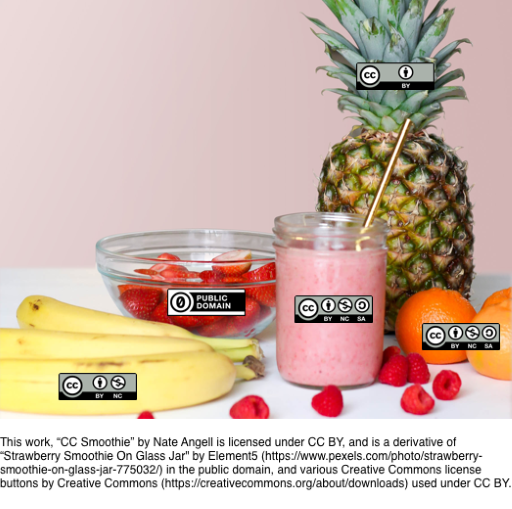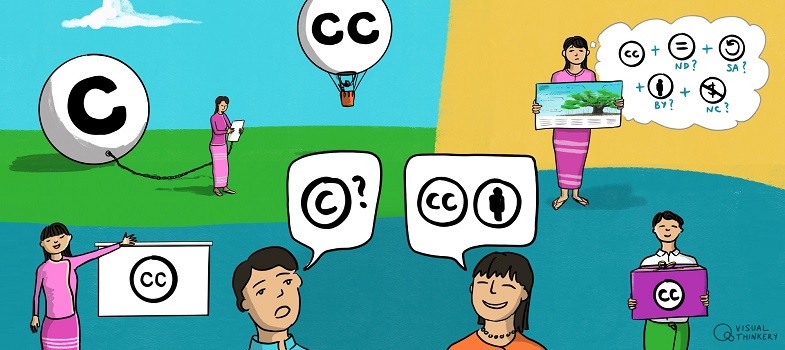Adaptation or remix?
A remix is a type of adaptation that blends together a combination of resources from different sources to create a wholly new creation. As the resources have been combined together seamlessly, you often cannot tell where one openly licensed work ends and another begins. An example of a remix could be a new textbook that you create by combining several OER with your own material to create a new textbook. While this flexibility is useful for the new creator, it is still important to provide attribution to the individual parts that went into making the adaptation.

A good way to illustrate how remix works is the analogy of a ‘smoothie’ drink. In the picture above, you can see that the smoothie drink (CC BY-NC-SA) has been created by blending together bananas (CC BY NC), strawberries (public domain), oranges (CC BY NC-SA) and pineapple (CC BY).
There are some important things to consider before we make the smoothie. First, in order to combine these fruits to make the smoothie, they need to have compatible licence types. This is why it is important to plan ahead when you want to combine different openly licensed resources together.
Second, it’s important to be aware of what licences work well together. The table below reviews what open licences are compatible with each other for remix purposes. The table includes CC0 and public domain. You can choose one licence type on the vertical and another licence type on the horizontal.
- The tick symbol (✔) means that that one licence type is compatible with another licence type. This is good news if you would like to create a remix using OER with these licences.
- A cross symbol (✘) means that the licences selected are incompatible for remixing. This means you cannot remix OER with these licence types.
| Public domain ‘no known copyright’ | Public domain ‘no rights reserved’ | CC BY | CC BY-SA | CC BY-NC | CC BY-ND | CC BY-NC-SA | CC BY-NC-ND | |
|---|---|---|---|---|---|---|---|---|
| HighlightedPublic domain ‘no known copyright’ | Highlighted✔ | Highlighted✔ | Highlighted✔ | Highlighted✔ | Highlighted✔ | Highlighted✘ | Highlighted✔ | Highlighted✘ |
| Public domain ‘no rights reserved’ | ✔ | ✔ | ✔ | ✔ | ✔ | ✘ | ✔ | ✘ |
| HighlightedCC BY | Highlighted✔ | Highlighted✔ | Highlighted✔ | Highlighted✔ | Highlighted✔ | Highlighted✘ | Highlighted✔ | Highlighted✘ |
| CC BY-SA | ✔ | ✔ | ✔ | ✔ | ✘ | ✘ | ✘ | ✘ |
| HighlightedCC BY-NC | Highlighted✔ | Highlighted✔ | Highlighted✔ | Highlighted✘ | Highlighted✔ | Highlighted✘ | Highlighted✔ | Highlighted✘ |
| CC BY-ND | ✘ | ✘ | ✘ | ✘ | ✘ | ✘ | ✘ | ✘ |
| HighlightedCC BY-NC-SA | Highlighted✔ | Highlighted✔ | Highlighted✔ | Highlighted✘ | Highlighted✔ | Highlighted✘ | Highlighted✔ | Highlighted✘ |
| CC BY-NC-ND | ✘ | ✘ | ✘ | ✘ | ✘ | ✘ | ✘ | ✘ |
Footnotes
This Remix chart was reformatted as part of the OEPS course Becoming an open educator (Section 4.2, ‘Remixing OER’). The original table is from Frequently Asked Questions by Creative Commons and licensed CC BY 4.0Let’s look at an example. Say I would like to remix textbook content licensed CC BY-NC with online course content that is licensed CC BY-SA. Are these licence types compatible?

That’s correct! Unfortunately I would not be able to remix these OER. This is because if I use CC BY-SA licensed material in a remix, I cannot combine it with OER that additionally requires me to prohibit commercial use. To do so would be a violation of the requirements of the CC BY-SA licence.
However, you would not be able to combine CC BY-SA and CC BY-NC-SA resources together. This is because you would be unable to abide by the requirement to license the resource both CC BY-SA and CC BY-NC-SA.
Let’s return to the example of our smoothie drink, which is licensed CC BY-NC-SA. Let’s look at the types of licences used in this combination. The smoothie drink has been created from banana (CC BY NC), strawberries (public domain), oranges (CC BY NC-SA) and pineapple (CC BY). The most restrictive licence used in this remix is the oranges (CC BY NC-SA). Use the chart above to review what licences CC BY NC-SA is compatible with.
Yes, that’s correct! You cannot combine CC BY NC-SA licensed resources with CC BY-SA, CC BY-ND or CC BY-NC-ND licensed resources. This is because two of these licence types contain the no-derivatives (ND) element (CC BY-ND and CC BY-NC-ND) and so cannot be adapted and shared with others. The remaining licence type CC BY-SA requires us to license any adapted versions of the material on the same licence type. Because the oranges already have a ‘SA’ requirement that is different to that of the CC BY-SA licence, we cannot combine these works. This means that if we wanted to use the oranges in our smoothie drink, only fruits in the Public Domain or licensed CC BY, CC BY-NC or CC BY-NC-SA could be combined.
As you can see, it’s very important to consider different licence types and to ensure that they are compatible before you start to combine them to make something new. As we’ve seen above, remix is easier if you are combining open resources which use more liberal licences, such as CC BY. Although you cannot include copyrighted material in your OER without permission, you can provide URLs to copyrighted material: for example, videos on YouTube that are not openly licensed.
What should I do if the OER I have found cannot be remixed?
If you have OER that cannot be remixed together, you could:
- look for alternative OER
- contact the rights holder/creator of the resource to see if they would be happy for you to use the resource in a different way – this would need to be acknowledged appropriately.
Adapting OER
